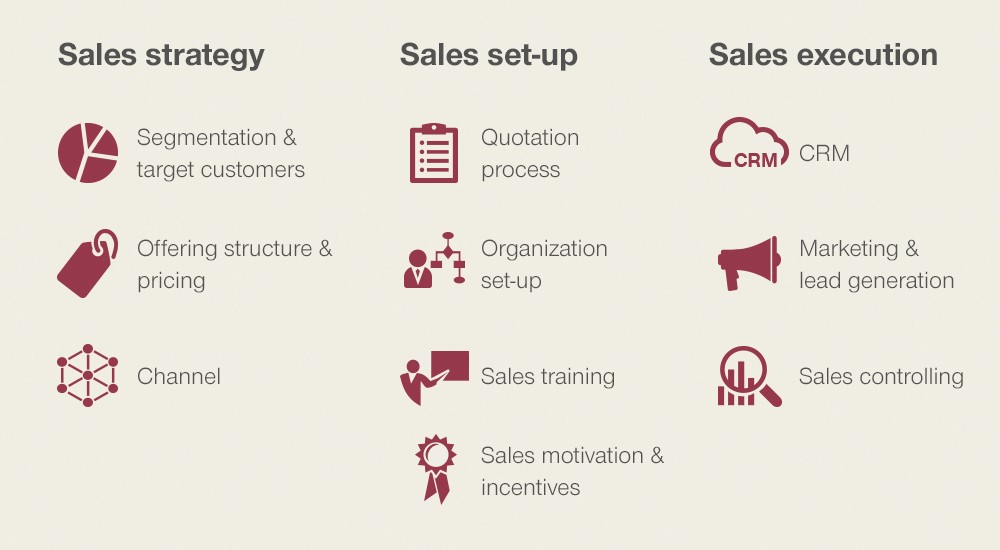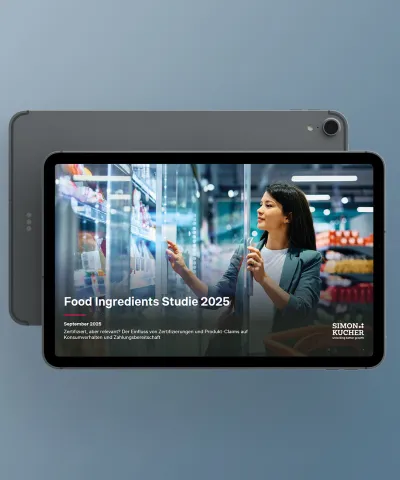Digital solutions are increasingly important for revenues. In part 1 of this series, Daniel Bornemann and Grigori Bokeria classified digital solutions into six categories. Now, in part 2, they describe how to adapt your traditional sales approach and prepare your salesforce for selling them in the most successful way.
So you’ve added digital solutions to your portfolio. Now your sales team can go out into the field and start selling them with all your other products, right? It sounds like the most straightforward tactic, but follow this approach and you will likely hear from your sales team something along the lines of…
“We have so many new digital solutions in the portfolio that I have lost track. I don’t even know to which customers I should offer these products!”
Or… “I have offered this digital solution to 10 customers – but the hit rate is very low. Most customers don’t seem interested. I won’t offer it anymore, I’ll stick to my good old machines.”
To avoid failure, you need to consider the differences of the digital solutions in your sales approach. We’ve outlined the key sales elements in the Simon-Kucher Sales Grid:

Reach out to us for a more detailed version of this framework, including a breakdown of all the sub-elements per category!
What is the best way to sell digital solutions?
There is no exact right or wrong way to sell a new digital product or service. Every product innovation has its own requirements depending on the solution type, features, target segments, customer benefits, etc. We previously described in part 1 of this series how digital solutions can be classified into six categories: Digital machine options, digital systems, software platforms, process optimization software, digitally enhanced services, and digital consulting. Now you have defined the category for your solution, the next step is to check the compatibility of your current sales approach. Let’s walk through the Sales Grid and answer some important questions surrounding the key sales elements:
SALES STRATEGY
Who are the target customers for your digital solutions?
Yes, major effort and investment went into developing your solution, but equally important is that your sales team knows who to sell it to. First, identify the target segment where your solution creates the most value, and only then shape your sales approach. Maybe your existing segmentation already correlates with the value your digital solution provides –you can sleep soundly at night. Yet, in many cases, it won’t. Before making any further decisions, it’s critical to determine which customers (new vs. existing, small vs. medium or large, industry?) should be targeted. Let’s take the example of a predictive maintenance solution that reduces customer downtime: Does the value of decreased downtime really correlate with the customer’s number of machines, or rather with the safety buffers its production operates with?
Who in the target customers’ organizations should your salesforce speak to?
Sometimes it’s the same people as with “the good old stuff”. But not always. Important aspects are size and structure of the customer’s organization and closeness of the digital solution to the existing offering. Sometimes your sales team will already know the contacts, or can at least open doors. In other cases you must start from scratch and find out. Don’t send out any marketing mailings on your solutions without answering this question first.
In which channels will you sell your digital solution?
Key here is whether to go direct or indirect. Typically B2B companies still focus very strongly on direct sales with external sales teams, but this doesn’t have to be the case for digital solutions. Startup FreightHub, a B2B platform bringing logistic companies together with merchants, heavily relies on the online channel and clever “pull” marketing to create customer leads. On the merchant side, only when customers are already “warmed up” does the phone sales team kick-in to close the deal. Key criteria are the number of potential target customers, the complexity of the solution, and its closeness to your current business.
SALES SET-UP
What is the right price model, metric, and level for your digital solution?
Transferring a traditional product’s pricing/offering structure directly to a digital solution risks money left on the table or even failure in the market. From a price model perspective, the most critical decision is between a “traditional” one-off price model, and an additional recurring component (i.e. two-part tariff or full-fledged subscription). In the digital age, many companies are succeeding with subscriptions: Customers are comfortable with using rather than owning – the key is clear argumentation that highlights value. Yet, there are limitations for subscription components, e.g. your solution could have significant one-off hardware or integration costs.
Price metrics allow you to differentiate price by segment willingness to pay. Typically for software products the “# of licenses” metric is used, but numerous other examples exist (i.e. # of connected machines, # of users, # of integrated tools, etc.). The most complicated task is finding a price metric in line with both willingness to pay and your company’s internal goals, such as measurability and costs.
Lastly, define the price level. A key mistake with enabler hardware is to calculate cost-plus and set prices too high. In situations with no competition (common with solution innovations) you should try to estimate the value of your different packages by segment and apply the “fair value pricing” method. If competitors are already on the market, you need to understand their significance and price level, then quantify your solution’s additional benefit.
Who should sell your digital solution?
Can you train your existing salesforce on the specific technical knowledge and skills? Do you need to bring in new salespeople, or even set up a dedicated digital sales unit to achieve your goals? If your aim is to tap into new segments, you may need to expand your resources to allow for a full dedication of your salesforce towards the new solutions and segments.
SALES EXECUTION
How do you measure sales success?
Controlling, motivation, and incentives will need to be adjusted to accommodate these new products and services. Sales reps will unlikely put in additional time and effort into cross-selling your new and digitally enhanced service if it isn’t incorporated into their commission structure. Likewise, determine and communicate goals and KPIs so that everyone has a realistic idea of what to achieve. These can be set on either an individual or team level.
A structured sales organization for selling digital solutions
Selling digital solutions can be a major challenge, and requires a different approach to traditional products. As R&D keep adding to the number of digital solutions in the pipeline and the portfolio increases, you can end up confusing reps with impossible targets. To make sure your digital products are a hit with both customers and sales professionals, you need a structured sales organization, specifically designed for selling digital solutions. We always recommend following a 3-step sales excellence approach:
- Start by determining what type of digital solution you are selling. Digital products can typically be classified into one of the six categories mentioned above. It’s essential to fully understand the key attributes and the benefits you deliver to the customer.
- Next, carry out benchmarking against best practices per digital solution type. Assess each sales lever and determine how you can best support your sales team in selling this solution. Don’t forget to answer the four key questions of “where,” “what,” “who,” and “how.”
- Finally, scale up gradually. Transforming into your target sales organization is a journey that won’t happen overnight. A healthy business is one that is able to grow. There will always be new products added to your portfolio, and the key to success is keeping your sales team flexible and skilled to sell them in a professional way.
Read more from our Sales Excellence for Digital Solutions series:
Part 1: Sales Excellence For Digital Solutions: The 6 Key Solution Categories
Part 3: Sales Benchmarking Analysis for Digital Solutions
Part 4: Caterpillar’s Integrated Sales Approach for Digital Solutions








